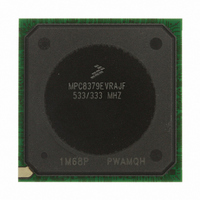MPC8379EVRAJF Freescale Semiconductor, MPC8379EVRAJF Datasheet - Page 62

MPC8379EVRAJF
Manufacturer Part Number
MPC8379EVRAJF
Description
MPU PWRQUICC II 533MHZ 689TEPBGA
Manufacturer
Freescale Semiconductor
Series
PowerQUICC II PROr
Datasheets
1.MPC8377EVRAGD.pdf
(126 pages)
2.MPC8377EVRAGD.pdf
(2 pages)
3.MPC8379VRAGD.pdf
(116 pages)
Specifications of MPC8379EVRAJF
Processor Type
MPC83xx PowerQUICC II Pro 32-Bit
Speed
533MHz
Voltage
1V
Mounting Type
Surface Mount
Package / Case
689-TePBGA II
Maximum Clock Frequency
533 MHz
Operating Supply Voltage
1.8 V to 2.5 V
Maximum Operating Temperature
+ 105 C
Mounting Style
SMD/SMT
I/o Voltage
1.8 V, 2.5 V, 3.3 V
Minimum Operating Temperature
0 C
Core Size
32 Bit
Program Memory Size
64KB
Cpu Speed
533MHz
Embedded Interface Type
DUART, HSSI, I2C, IPIC, JTAG, SPI, USB
Digital Ic Case Style
BGA
No. Of Pins
689
Rohs Compliant
Yes
For Use With
MPC8377E-RDBA - BOARD REF DES MPC8377 REV 2.1MPC8377E-MDS-PB - BOARD MODULAR DEV SYSTEM
Lead Free Status / RoHS Status
Lead free / RoHS Compliant
Features
-
Lead Free Status / Rohs Status
Lead free / RoHS Compliant
Available stocks
Company
Part Number
Manufacturer
Quantity
Price
Company:
Part Number:
MPC8379EVRAJF
Manufacturer:
Freescale Semiconductor
Quantity:
135
Company:
Part Number:
MPC8379EVRAJF
Manufacturer:
Freescale Semiconductor
Quantity:
10 000
PCI Express
15.4.1
Table 52
specified at the component pins.
62
Unit interval
Differential
peak-to-peak output
voltage
De-emphasized
differential output
voltage (ratio)
Minimum Tx eye width The maximum transmitter
Maximum time between
the jitter median and
maximum deviation
from the median
D+/D– Tx output
rise/fall time
RMS AC peak common
mode output voltage
Absolute delta of DC
common mode voltage
during LO and electrical
idle
Parameter
defines the specifications for the differential output at all transmitters. The parameters are
Differential Transmitter (Tx) Output
MPC8377E PowerQUICC II Pro Processor Hardware Specifications, Rev. 4
Each U
ppm. U
for Spread Spectrum Clock
dictated variations.
V
V
Ratio of the V
second and following bits after
a transition divided by the
V
transition.
jitter can be derived as
T
U
Jitter is defined as the
measurement variation of the
crossing points (V
V) in relation to a recovered Tx
UI. A recovered Tx UI is
calculated over 3500
consecutive unit intervals of
sample data. Jitter is
measured using all edges of
the 250 consecutive UI in the
center of the 3500 UI used for
calculating the Tx UI.
—
V
V
V
|V
|V
V
Idle)
V
|V
V
|V
Idle]
TX-MAX-JITTER
PEDPPTX
TX-D-
PEDPPTX
PEACPCMTX
TXD-
TX-CM-DC
TX-CM-Idle-DC (During Electrical
TX-CM-DC
TX-CM-Idle-DC
PEEWTX
TX-D+
TX-CM-DC (during LO)
TX-D+
TX-D+
Table 52. Differential Transmitter (Tx) Output Specifications
|<=100 mV
|/2 – V
|
PETX
PETX
– V
– V
– V
Conditions
= 0.3 UI.
of the first bit after a
= 2 × |V
= DC
= DC
TX-D-
TX-D-
TX-D-
TX-CM-DC
does not account
is 400 ps ± 300
= RMS(|V
PEDPPTX
= DC
= 1 –
(avg)
|/2
(avg)
|/2 [LO]
|/2 [Electrical
PEDPPTX
TX-D+
(avg)
of
of
)
–
of the
TXD+
–
of
= 0
–
V
T
T
TX-CM-DC- ACTIVE-
TX-EYE-MEDIAN-to-
TX-RISE
V
V
V
MAX-JITTER
IDLE-DELTA
TX-DE-RATIO
Symbol
TX-CM-ACp
TX-DIFFp-p
T
TX-EYE
UI
, T
TX-FALL
399.88
0.125
–3.0
0.70
Min
0.8
—
—
0
Typical
–3.5
400
—
—
—
—
—
—
400.12
Freescale Semiconductor
Max
–4.0
0.15
100
1.2
—
—
20
Units
mV
mV
dB
ps
UI
UI
UI
V
Notes
2, 3
2, 3
2, 5
1
2
2
2
2













